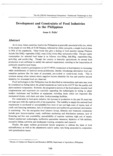Development and Constraints of Food Industries in the Philippines
JIRCAS international symposium series
| ISSN | 13406108 |
|---|---|
| 書誌レコードID(総合目録DB) | AA1100908X |

本文フルテキスト
intlsymp-7_139-162.pdf668.88 KB
As in many Asian countries, food in the Philippines is generally associated with rice, which is the staple of over 80% of 70 M Filipinos, followed by white corn grits, a staple food of close to 20% of the population. Other foods that give a feeling of food security among Filipinos include fish (16%), vegetables (13%), meat (11%), fruits (9%), and poultry (2%). The per capita consumption for selected food items is as follows: rice-103kg, fish-36kg, vegetables-14kg, pork-8kg, and poultry-5kg. Though the country is basically agricultural, its annual food production is not sufficient to satisfy the national requirement, resulting in the importation of politically sensitive food items.
With the country's participation in GATT-WTO, investment in food industry is increasing while establishment of fastfood stores proliferates, thereby introducing alternative food consumption patterns like the taste of processed, pre-cooked or ready-to-eat foods. This is common among urban centers where negative income elasticity for rice and positive income elasticity for processed food are observed.
Food technologies in the Philippines may be described as intermediate and some may even be considered as falling below the global standards set forth in the GATT like the quality and phyto-sanitary components. However, the progressive sectors of the food industry (mostly food conglomerates and exporters) are currently upgrading the technologies by trying to adopt modern techniques and facilities or equipment, including those which are · imported like mechanical dryers, cold chain and other food-processing facilities.
For constraints in food grain industry, the increase in production in the past 20 years has not kept pace with the rapid growth of the population. The inability to supply the national food requirement is attributed to unavailability/low level of use and high costs of inputs, lack of credit and financing assistance, lack of infrastructure and ineffective government intervention in marketing. For the non-grains food industry (crops, fisheries and livestock) constraints include poor farm-to-market roads, inefficient marketing and distribution systems, lack of financing and low cost availability, unavailability of superior varieties, high cost of inputs, limited postharvest technologies, ineffective quarantine measures, depletion of fish habitats, excessive fishing activities and inadequate training, extension and research.
Finally, the paper outlines government banner programs to address the issue of food self-sufficiency as well as the adjustments and/or safety nets being promoted in conjunction with globalization issues.
With the country's participation in GATT-WTO, investment in food industry is increasing while establishment of fastfood stores proliferates, thereby introducing alternative food consumption patterns like the taste of processed, pre-cooked or ready-to-eat foods. This is common among urban centers where negative income elasticity for rice and positive income elasticity for processed food are observed.
Food technologies in the Philippines may be described as intermediate and some may even be considered as falling below the global standards set forth in the GATT like the quality and phyto-sanitary components. However, the progressive sectors of the food industry (mostly food conglomerates and exporters) are currently upgrading the technologies by trying to adopt modern techniques and facilities or equipment, including those which are · imported like mechanical dryers, cold chain and other food-processing facilities.
For constraints in food grain industry, the increase in production in the past 20 years has not kept pace with the rapid growth of the population. The inability to supply the national food requirement is attributed to unavailability/low level of use and high costs of inputs, lack of credit and financing assistance, lack of infrastructure and ineffective government intervention in marketing. For the non-grains food industry (crops, fisheries and livestock) constraints include poor farm-to-market roads, inefficient marketing and distribution systems, lack of financing and low cost availability, unavailability of superior varieties, high cost of inputs, limited postharvest technologies, ineffective quarantine measures, depletion of fish habitats, excessive fishing activities and inadequate training, extension and research.
Finally, the paper outlines government banner programs to address the issue of food self-sufficiency as well as the adjustments and/or safety nets being promoted in conjunction with globalization issues.
| 作成者 | Josue S. Falla |
|---|---|
| 公開者 | Japan International Research Center for Agricultural Sciences |
| オンライン掲載日 | |
| 号 | 7 |
| 開始ページ | 139 |
| 終了ページ | 162 |
| 言語 | eng |
